Discover the timeless art of jewelry making and unleash your creativity with our comprehensive DIY guide. Whether you are a beginner or an experienced crafter, making jewelry at home allows you to express your personal style, create unique pieces, and explore various techniques. From homemade jewelry making to DIY jewelry crafts, this guide will provide you with step-by-step instructions, handcrafted jewelry ideas, and everything you need to embark on your own jewelry-making journey.
Key Takeaways:
- Learn the art of jewelry making at home with our step-by-step instructions.
- Explore various techniques, from beaded jewelry to wire wrapping.
- Gather the necessary tools and materials to start your jewelry-making projects.
- Set up a dedicated workspace for comfortable and safe jewelry making.
- Choose a jewelry project that matches your personal style and interests.
Types of Jewelry Making
Jewelry making is a diverse craft that encompasses various techniques and materials. Whether you are a beginner or an experienced jewelry maker, there are several types of jewelry making for you to explore and create stunning pieces. Here are some popular types of jewelry making:
Beaded Jewelry
One of the most versatile and accessible forms of jewelry making is beaded jewelry. This technique involves stringing beads together using a needle and thread or wire. Beaded jewelry allows you to unleash your creativity by choosing from a wide range of beads, including glass, gemstone, seed beads, and more. This technique is perfect for crafting necklaces, bracelets, earrings, and even statement pieces.
Wire Jewelry
Wire jewelry making utilizes wire wrapping techniques to create intricate and unique designs. With wire, you can create beautiful shapes, loops, coils, and wraps to enhance your jewelry designs. Wire jewelry allows for endless possibilities, from delicate wire-wrapped pendants to intricately woven wire earrings. This technique provides flexibility and allows you to experiment with different wire gauges and materials.
Silver and Goldsmithing Jewelry
For those interested in working with precious metals, silver and goldsmithing jewelry is a popular choice. This technique involves shaping and manipulating silver and gold using various tools and techniques, such as hammering, sawing, soldering, and casting. With silver and goldsmithing, you can create stunning rings, pendants, bracelets, and more, showcasing the beauty and elegance of these precious metals.
Glass Fused Jewelry
Glass fused jewelry involves using a kiln to fuse and shape glass components into unique jewelry pieces. This technique allows you to work with glass in its molten state, creating beautiful and intricate designs. From fused glass pendants to vibrant glass earrings, glass fused jewelry offers a wide range of possibilities to explore your artistic side.
Metal Clay Jewelry
Metal clay jewelry is a fascinating technique that involves working with a clay-like material that contains metal particles. After shaping and sculpting the metal clay, it is fired in a kiln, resulting in a solid metal piece. This technique allows you to create intricate and detailed designs, showcasing the unique texture and properties of metal. Metal clay jewelry is perfect for creating one-of-a-kind pendants, earrings, and even rings.
| Type of Jewelry Making | Description |
|---|---|
| Beaded Jewelry | Stringing beads using a needle and thread or wire |
| Wire Jewelry | Utilizing wire wrapping techniques to create intricate designs |
| Silver and Goldsmithing Jewelry | Shaping and manipulating precious metals like silver and gold |
| Glass Fused Jewelry | Using a kiln to fuse and shape glass components |
| Metal Clay Jewelry | Working with a clay-like material containing metal particles |
These are just a few examples of the types of jewelry making techniques available. Whether you prefer the elegance of silver and gold, the versatility of beads, or the artistry of glass and metal clay, there is a jewelry making technique that will captivate your imagination and allow you to create stunning pieces of wearable art.
How to Make Jewelry at Home
Making jewelry at home is a rewarding and creative process that allows you to express your personal style and create unique pieces. Whether you’re a beginner or an experienced jewelry maker, the following steps will guide you through the jewelry making process to help you bring your ideas to life.
1. Choosing a Jewelry Project
Start by deciding on a jewelry project that interests you. This can be anything from a simple beaded bracelet to a more complex wire-wrapped pendant. Consider your skill level, the techniques you want to explore, and the materials you want to work with. Take inspiration from online jewelry designs, jewelry stores, or sketch out your own ideas.
2. Gathering Tools and Materials
Once you’ve chosen your jewelry project, gather the necessary tools and materials. Basic tools like pliers, wire cutters, and rulers are essential for most jewelry making projects. Depending on your chosen technique, you may need more specialized equipment, such as a kiln for glass fused jewelry or a torch for soldering metal. Acquire the tools and materials you need from craft stores, online suppliers, or specialty jewelry stores.
3. Setting Up a Workspace
Creating a dedicated workspace is crucial for an enjoyable and efficient jewelry making experience. Find a well-lit area with good natural or artificial light to ensure accurate work. Consider proper ventilation, especially if you’re working with materials that emit fumes. Don’t forget to equip your workspace with safety equipment, such as goggles and a mask. Set up a sturdy workbench and a comfortable chair to promote productivity and comfort.
4. Following the Jewelry Making Process
Once you have your jewelry project, tools, and workspace ready, you can begin the jewelry making process. Follow step-by-step instructions tailored to your chosen project. These instructions can be found in books, online tutorials, or even jewelry making classes. Embrace practice and experimentation to improve your skills and create unique jewelry pieces.
5. Tips for Success
As you embark on your jewelry making journey, keep the following tips in mind:
“Every piece of jewelry you make is an opportunity to learn and grow as a jewelry maker.”
- Start with simple projects and gradually challenge yourself with more complex designs.
- Be patient and take your time to achieve the results you desire.
- Experiment with different materials, colors, and textures to add variety to your designs.
- Stay organized by keeping track of your tools and materials.
- Connect with other jewelry makers through online communities or local meetups to exchange ideas and tips.
By following these steps and embracing your creativity, you’ll be well on your way to making beautiful handcrafted jewelry in the comfort of your own home. Happy jewelry making!
Choosing a Jewelry Project
When it comes to choosing a jewelry project, the possibilities are endless. Whether you’re a beginner or an experienced jewelry maker, finding inspiration and designing your piece is key to creating a unique and personal work of art.
To begin, immerse yourself in the world of jewelry designs. Browse online galleries, explore social media platforms, and visit local jewelry stores to discover a wide range of styles and techniques. These sources can ignite your creative spark and offer valuable insights into the latest trends.
Additionally, sketching out your own designs allows you to unleash your imagination and capture your vision. Consider the type of materials you want to work with, such as beads, metal, or glass. Each material possesses its own characteristics and unleash different design possibilities.
Designing your piece on paper helps you plan out the necessary materials and tools. It allows you to think ahead, anticipate challenges, and visualize the final result. Whether you prefer a simple and delicate necklace or a bold statement ring, having a design blueprint ensures a smoother and more satisfying jewelry-making process.
Remember, inspiration can be found everywhere, from nature’s beauty to iconic architectural structures. Don’t hesitate to explore various artistic disciplines, such as painting, sculpture, or fashion, to find unconventional sources of inspiration. Let your creativity soar and translate your unique vision into a stunning piece of jewelry.
“Design is not just what it looks like and feels like. Design is how it works.” – Steve Jobs
Materials and Techniques
| Materials | Techniques |
|---|---|
| Beads | Stringing, weaving, bead embroidery |
| Metal | Wire wrapping, soldering, etching |
| Glass | Fused glass, lampworking, stained glass techniques |
| Precious stones | Stone setting, wire wrapping |
Choosing the right materials and techniques enhances the beauty and uniqueness of your jewelry piece. The table above highlights some popular materials and the corresponding techniques associated with each.
Experimentation is key in jewelry making. Don’t be afraid to mix and match materials, combine various techniques, and push your creative boundaries. This is your opportunity to express your personal style and create a wearable work of art.
Gathering Tools and Materials
If you want to make jewelry at home, you’ll need to gather a variety of tools and materials. Whether you’re a beginner or an experienced jewelry maker, having the right equipment is essential for creating beautiful pieces. Here are some of the basic tools and advanced equipment you may need:
Basic Tools
- Pliers: Pliers are versatile tools that will help you bend and shape wires, open and close jump rings, and hold small components securely. Look for a set of jewelry-making pliers that includes round nose, flat nose, and chain nose pliers.
- Wire Cutters: Wire cutters are used to trim wires to your desired length. They come in different sizes and styles, so choose a pair that is suitable for the gauge of wire you’ll be working with.
- Rulers: Rulers are essential for measuring and marking your materials accurately. Look for a ruler with both metric and imperial measurements.
- Other Tools: Depending on your projects, you may also need tools like a bead reamer, needle files, jewelry hammers, and a bead scoop.
Advanced Equipment
- Kiln: If you’re interested in glass fused jewelry, you’ll need a kiln to heat and melt the glass. Kilns can reach high temperatures, so make sure to follow safety guidelines.
- Torch: Soldering metal requires the use of a torch, which produces a high-temperature flame to join metal components together. Safety precautions, such as proper ventilation and protective eyewear, are necessary when using a torch.
- Polishing Machine: To give your finished jewelry a professional-looking shine, you can use a polishing machine. These machines utilize different attachments and polishing compounds to achieve a smooth and glossy surface.
Acquiring all the necessary tools and materials can be done through various sources:
- Craft Stores: Visit local craft stores to explore a wide range of jewelry making tools and materials. The advantage of shopping in-person is that you can see and feel the tools before making a purchase.
- Online Suppliers: Online suppliers offer convenience and a wide selection of tools and materials. You can compare prices and read customer reviews to make informed decisions.
- Specialty Jewelry Stores: Specialty jewelry stores cater specifically to jewelry makers and carry an extensive range of tools and materials. These stores often provide expert advice and guidance.
| Tool/Equipment | Description | Where to Acquire |
|---|---|---|
| Pliers | Versatile tools for bending, shaping, and securing components | Craft stores, online suppliers, specialty jewelry stores |
| Wire Cutters | Used to trim wires to desired length | Craft stores, online suppliers, specialty jewelry stores |
| Rulers | Essential for measuring and marking materials | Craft stores, online suppliers, specialty jewelry stores |
| Kiln | Necessary for glass fused jewelry making | Craft stores, online suppliers, specialty jewelry stores |
| Torch | Used for soldering metal components | Craft stores, online suppliers, specialty jewelry stores |
| Polishing Machine | Provides a professional finish to jewelry pieces | Craft stores, online suppliers, specialty jewelry stores |
Having the right tools and materials is crucial for successful jewelry making. Whether you’re starting with the basics or exploring advanced techniques, investing in quality tools will make a significant difference in the outcome of your creations.
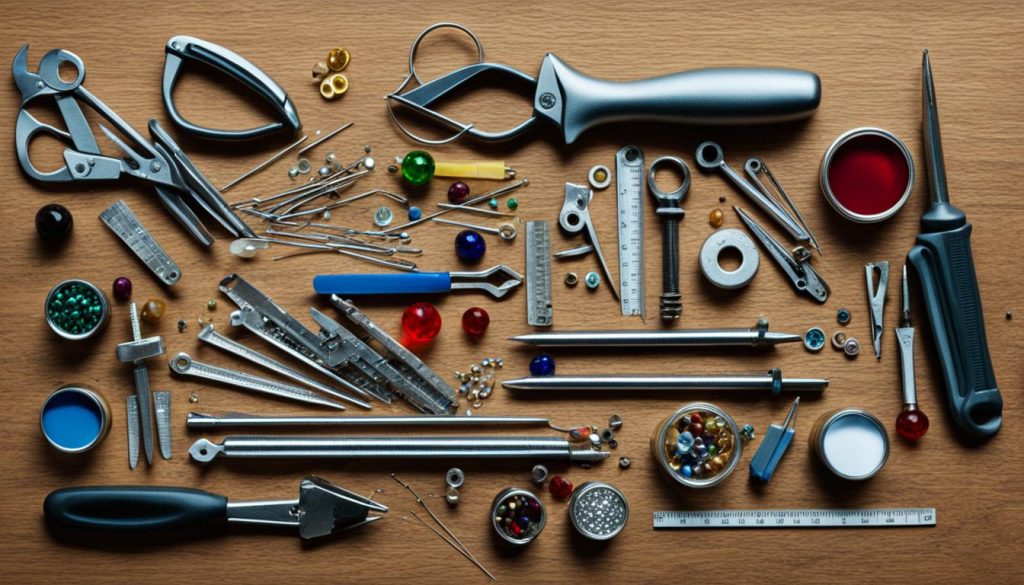
Setting Up a Workspace
Creating a dedicated workspace for jewelry making is crucial for your comfort and safety. A well-organized and well-equipped jewelry making workspace will allow you to focus on your craft and produce high-quality pieces. Here are some key elements to consider when setting up your jewelry making workspace:
Lighting
Good lighting is essential for accurate work in jewelry making. Choose a well-lit area with ample natural light. If natural light is limited, use artificial lighting that closely resembles natural light to ensure accurate color perception. Position your workbench near a window or invest in adjustable lamps that provide focused lighting.
Ventilation
Proper ventilation is crucial, especially when working with materials like solder or adhesive. These materials can release fumes that may be harmful if inhaled. Ensure your workspace has adequate airflow by opening windows or using a ventilation system or fan. Consider using a fume extractor or wearing a mask when working with potentially hazardous materials.
Safety Equipment
Protecting yourself is essential in any workspace, and jewelry making is no exception. Invest in safety equipment such as safety goggles to shield your eyes from flying debris and a dust mask to protect against harmful particles or fumes. It’s also a good practice to keep a first aid kit nearby in case of any accidents.
Workbench and Chair
A sturdy workbench is essential for jewelry making. Choose a workbench that provides ample space for your tools, materials, and projects. Make sure it is stable and comfortable to work on for extended periods. Additionally, invest in a comfortable chair that provides proper support to reduce strain and fatigue during long jewelry-making sessions.
Organizational Storage
Keep your workspace organized by investing in storage solutions that allow easy access to your tools and materials. Consider using small drawers, bins, or jars to categorize and store your supplies. Labeling containers will help you locate items quickly and maintain a clutter-free workspace.
Essential Elements of a Jewelry Making Workspace
| Workspace Element | Description |
|---|---|
| Lighting | Ensure your workspace has good natural or artificial lighting for accurate work. |
| Ventilation | Proper ventilation is necessary when working with certain materials to protect against fumes. |
| Safety Equipment | Invest in safety goggles, a dust mask, and a first aid kit to protect yourself from hazards. |
| Workbench and Chair | Choose a sturdy workbench and a comfortable chair to support your jewelry-making activities. |
| Organizational Storage | Implement storage solutions to keep your workspace organized and easily accessible. |
By setting up a well-equipped and well-organized jewelry making workspace, you’ll create a comfortable and efficient environment that enhances your creativity and allows you to focus on crafting stunning jewelry pieces.
Getting Started: Step-by-Step Instructions
Now that you have all your tools, materials, and a well-equipped workspace, it’s time to dive into the world of jewelry making! Follow these step-by-step instructions to bring your creative visions to life and craft stunning pieces of jewelry.
1. Choose a Jewelry Project: Select a project that piques your interest and matches your skill level. Whether it’s a beaded necklace, wire-wrapped earrings, or a metal clay pendant, find a project that excites you.
2. Access Project Tutorials: For detailed guidance and inspiration, leverage project tutorials available online or in jewelry making books. These resources provide you with valuable insights, expert tips, and visual aids that simplify the learning process.
3. Interactive Learning: Consider supplementing your self-learning with interactive experiences. Enroll in jewelry making classes where you can engage with knowledgeable instructors and fellow enthusiasts. Taking classes allows you to ask questions, receive personalized feedback, and learn from hands-on demonstrations.
4. Experiment and Practice: As with any creative skill, practice makes perfect. Don’t be afraid to experiment with different techniques, materials, and designs. This is your opportunity to unleash your artistic flair and create truly one-of-a-kind pieces.
Pro Tip: Don’t limit yourself to a single technique or style. Explore and combine various jewelry making techniques to develop your unique signature style.
See the Results of Your Masterpiece
To help you visualize the process, here’s an example of a simple beaded bracelet project:
| Materials | Tools |
|---|---|
|
|
- Measure the desired length of your bracelet and cut the elastic cord accordingly.
- Thread the beading needle, and begin stringing your chosen beads onto the elastic cord, leaving enough length at the end to attach the clasp.
- Secure the clasp by tying a knot with the elastic cord.
- Trim any excess cord, and your beaded bracelet is complete!
Congratulations! You’ve successfully completed your first jewelry making project. With each new creation, you’ll gain confidence and develop skills that will take your designs to new heights.
The History of Jewelry Making
Jewelry making has a rich history that spans thousands of years and is found in cultures around the world. From ancient civilizations to modern times, jewelry has been a form of personal adornment, reflecting individual style and cultural significance. The techniques and materials used in jewelry making have evolved over time, but the artistry and craftsmanship remain timeless.
Throughout history, jewelry has held great value and has been associated with various meanings and purposes. In ancient times, jewelry was often used as a symbol of status and wealth, worn by royalty and nobility to display their power and affluence. It served as a form of currency and could be easily traded or pawned during times of economic turmoil.
Ancient jewelry was crafted using a wide range of materials, including precious metals like gold and silver, gemstones, shells, bones, and even feathers. Each culture had its own unique style and techniques, resulting in jewelry pieces that were not only beautiful but also reflected the cultural beliefs and traditions of the people who wore them.
“Jewelry was not only a sign of wealth but also played a significant role in religious and spiritual ceremonies, as well as in rituals marking important life events.”
For example, ancient Egyptian jewelry often featured intricate designs with symbolic motifs such as scarabs, birds, and serpents, reflecting their beliefs in life after death and the importance of protection. In ancient Rome, jewelry was worn as a symbol of social status and power, with elaborate pieces adorned with gemstones and cameos.
Over time, jewelry making techniques and styles have evolved, influenced by cultural exchanges, trade routes, and advancements in technology. With the rise of the Renaissance in Europe, jewelry became more intricate and detailed, showcasing the skill and creativity of artisans.
The cultural significance of jewelry continues to thrive in modern times. Today, jewelry is not only worn for adornment but also as a means of self-expression, representing personal style, values, and beliefs. It serves as a reminder of cherished memories, relationships, and milestones in one’s life.
In conclusion, the history of jewelry making is a testament to the artistry, creativity, and cultural significance embedded in each piece. From ancient civilizations to the present day, jewelry has remained an enduring form of personal adornment, with each piece telling a unique story.
Learning Jewelry Making
Learning the art of jewelry making opens up a world of creativity and self-expression. Whether you dream of designing your own unique pieces or turning your passion into a profession, there are various ways to embark on your jewelry making journey.
One of the most effective ways to learn jewelry making is by enrolling in jewelry making classes. These classes, whether conducted in person or online, provide a structured learning environment with experienced instructors who can guide you through essential skills and techniques. From basic beading to advanced metalworking, these classes cater to different skill levels and interests.
If structured classes don’t fit your schedule or budget, you can also teach yourself jewelry making. Books, tutorials, and online resources offer a wealth of information and step-by-step guides to help you learn at your own pace. Practice is key, so set aside dedicated time to experiment with different materials and techniques.
“The first step towards learning is the desire to learn.”
– Silversmith instructor, Emma Thompson
Creating a studio at home provides a space where you can fully immerse yourself in the craft of jewelry making. Having a dedicated workspace not only allows for maximum concentration but also provides convenience and accessibility. You can set up your studio with essential tools, workbenches, and storage solutions that suit your needs and preferences.
Let your creativity flow in the comfort of your own studio, where you can explore new designs, experiment with different materials, and hone your skills. The possibilities are endless when you have a space solely dedicated to your jewelry making endeavors.
Comparison of Learning Methods
| Learning Method | Advantages | Disadvantages |
|---|---|---|
| Jewelry Making Classes |
|
|
| Self-Teaching |
|
|
Whichever learning method you choose, be it classes or self-teaching, the journey of learning jewelry making is a fulfilling and enriching experience. It’s a chance to develop your skills, unlock your creativity, and create beautiful pieces of wearable art that reflect your unique style and personality.
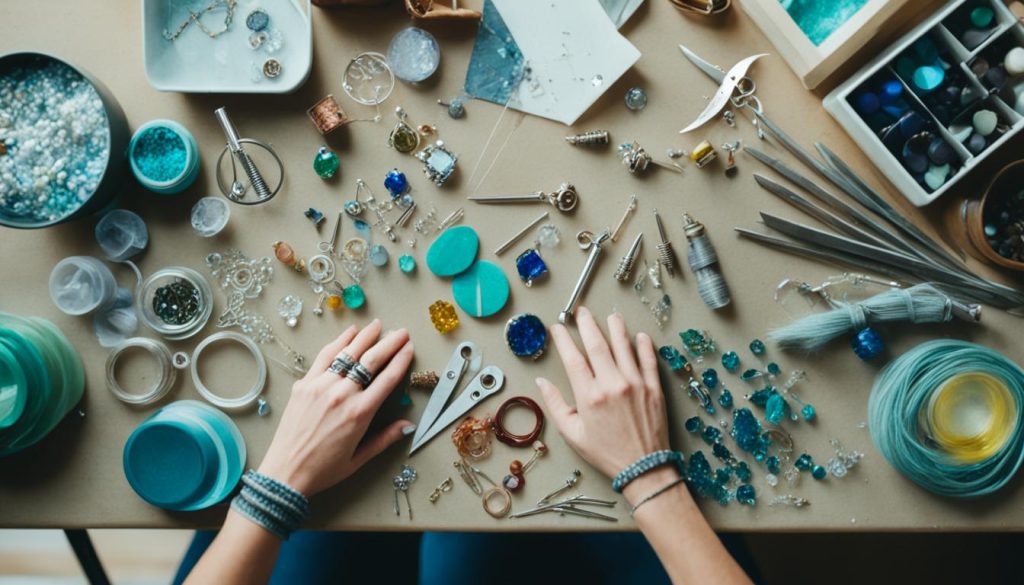
Jewelry Making as a Hobby vs. Profession
Jewelry making is a versatile craft that can be enjoyed as both a hobby and a profession. Whether you’re looking for a creative outlet or aiming to turn your passion into a full-time career, jewelry making offers endless possibilities for artistic expression and personal growth.
As a hobby, jewelry making allows you to explore different techniques and materials, providing a rewarding and relaxing pastime. You can create personalized pieces for yourself and loved ones, adding a unique touch to your style. With no pressure to meet deadlines or market your creations, you have the freedom to experiment and enjoy the process of making jewelry for pure enjoyment.
“Jewelry making as a hobby allows you to unleash your creativity without the constraints of a commercial environment. It’s a wonderful way to express yourself and create one-of-a-kind pieces that reflect your personal style.”
On the other hand, turning jewelry making into a profession requires a deeper commitment. It involves investing more time, effort, and resources into your craft. Marketing your work, building a brand, and establishing a customer base become integral parts of your journey towards becoming a professional jeweler.
Professional jewelers often specialize in specific techniques and alloys, honing their skills to create unique and high-quality pieces. They participate in trade shows, exhibitions, and online platforms to showcase their collections and attract potential clients. This level of dedication and specialization can lead to opportunities for collaborations, commissions, and recognition within the jewelry industry.
To pursue jewelry making professionally, it’s crucial to invest in equipment and education. You may need advanced tools, machinery, and materials to create more intricate designs and meet the demands of your customers. Additionally, continuous learning and training to enhance your skills and stay updated with the latest trends and techniques are essential for professional growth.
Comparison of Jewelry Making as a Hobby and Profession
| Jewelry Making as a Hobby | Jewelry Making as a Profession |
|---|---|
| Offers a creative outlet | Opportunity for artistic expression and skill development |
| Relaxing and enjoyable pastime | Requires a deeper commitment and dedication |
| Freedom to explore and experiment | Focus on market trends and customer demands |
| Personalized pieces for yourself and loved ones | Creating collections for a target audience |
| No pressure to meet deadlines or market your creations | Investment in marketing, branding, and establishing a customer base |
| Lower financial investment | Higher financial investment for equipment, materials, and education |
Whether you choose jewelry making as a hobby or profession, it’s a craft that offers immense satisfaction and the potential for personal and professional growth. The joy of designing and creating beautiful pieces with your own hands is incomparable, regardless of the path you choose.
Conclusion
In conclusion, jewelry making at home is a fulfilling and rewarding craft that allows you to unleash your creativity and create unique pieces of adornment. With the right tools, materials, and techniques, anyone can learn to make beautiful handcrafted jewelry.
Whether you choose to make jewelry as a hobby or pursue it as a profession, the possibilities for creativity and self-expression are endless. By exploring different techniques and experimenting with various materials, you can develop your own signature style and create jewelry that reflects your personal taste.
So, why wait? Start your jewelry making journey today and unlock your artistic potential. Whether you’re beading, wire wrapping, or working with precious metals, there are countless resources available to guide you through the process and help you master the art of jewelry making at home.
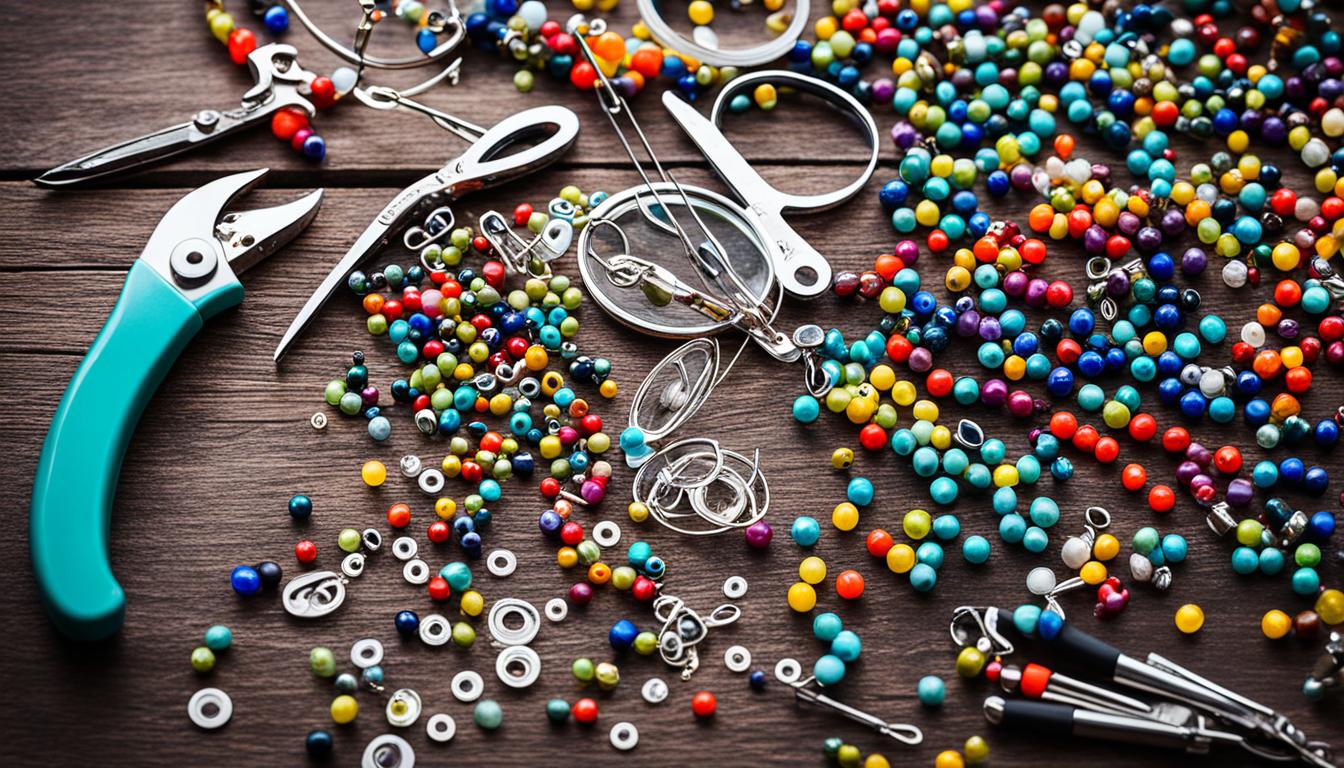

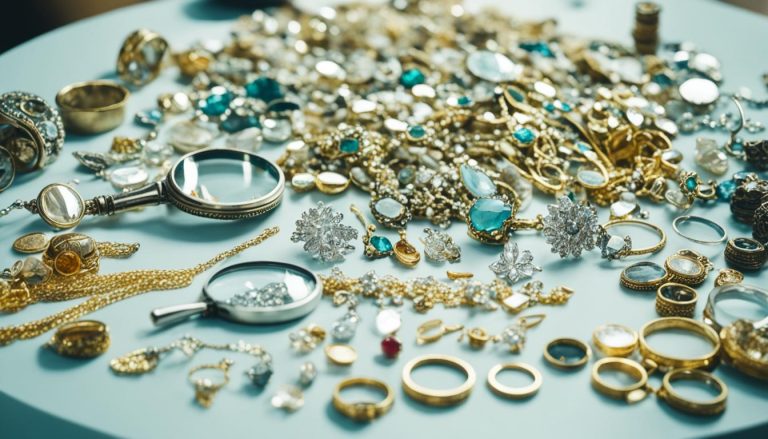



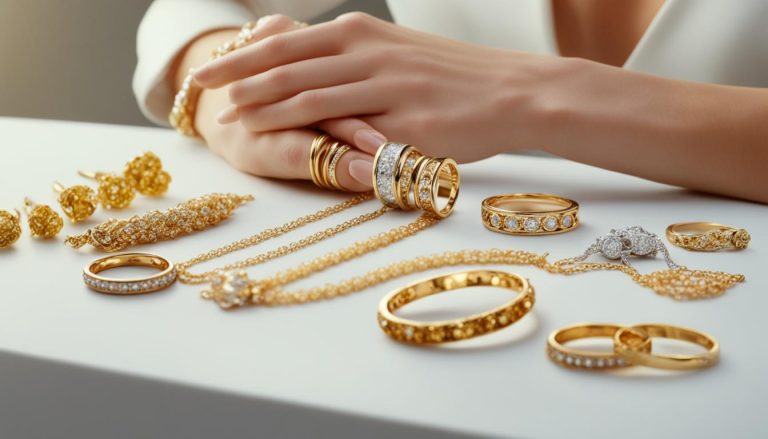
+ There are no comments
Add yours